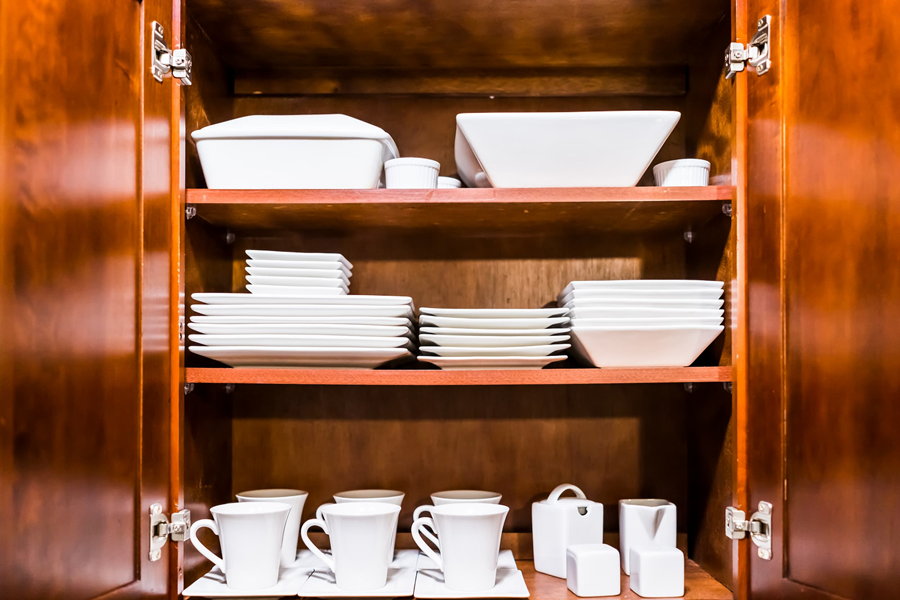How to declutter your kitchen

If you’ve made it your project to declutter your home, you may know how daunting the task can seem once you get up close to it. After all, most of the items you’re sorting through have been accumulated over years and years – how can you cut down on so much in just a weekend or even an afternoon?
The answer is to step back, take a breather and make a plan of attack. The first and most impactful way you can break down a big decluttering project is to split it up into different rooms and tackle one at a time. In this blog, we explore how to declutter a kitchen – the hub of any home.
How do I declutter my kitchen?
The kitchen is a room you use several times a day, whether you’re fixing yourself a sandwich alone or cooking an elaborate meal for loved ones. Unfortunately, it can easily get cluttered with things from other areas of the home as well as kitchenware – so a good declutter can be a brilliant way to stay on top of things in one of the busiest rooms of the home.
Below, we’ve compiled a list of tips and tricks to make this task that much simpler. Keep reading to learn more.
Determine your end goal
Proper preparation is key to any project, and knowing what you’d like to accomplish can make it easier to direct your efforts and see progress.
Consider what your goal is for this decluttering project. Would you like to make room for something, such as the baking ingredients and equipment you’d need to develop a hobby of baking? Or perhaps you just want to get rid of all the things you don’t use so you’ve got space for more groceries?
Whatever the case, keep your ‘why’ in mind as you go – it may help you to make decisions about what to discard, as well as how you’ll organise what remains.
Begin with the counters
When you first walk into your kitchen, it’s the visible clutter on any worktops, shelves and tables that will attract the most attention and make the room look untidy. So, to make quick progress and see the benefits immediately, start by decluttering these areas.
The added bonus to starting with these areas is that it gives you somewhere to work when you move onto the rest of the room.
Don’t overlook edible clutter
In most rooms of the home, decluttering is all about non-perishables – clothes, ornaments, entertainment and more. But in the kitchen, it’s not uncommon for one of the biggest clutter culprits to be food you’ve forgotten you have.
This is particularly true for staple items like pasta, rice and tinned goods. While it’s sensible to keep a stock of these as they last a long time and can be helpful if you can’t get to the shops for whatever reason, it can be easy to overstock without realising.
Take the time to go through your food stocks and discard what’s not needed. If it’s past the use-by date, throw it out; if it’s still good to eat, consider donating it to a local charity or food bank, as it may be greatly appreciated by someone in need.
Use temporary storage solutions
One thing that can make decluttering a kitchen tricky is the fact that it’s constantly in use. Chances are you won’t be able to complete your project in a single morning or afternoon – and you don’t want to have to cook a meal surrounded by clutter halfway through a tidy-up.
To make things easier, consider using a box or tray that you can lift and carry to another room when necessary. While decluttering, take items from their place and put them in the box or tray instead of on the worktops. That way, if you haven’t found a new home for them by the time you need to use the kitchen for its intended purpose, you can simply move your project out of the way so you can cook safely.
Prioritise multi-use items wherever possible
There are all kinds of kitchen gadgets on the market, and many of them can be very useful. But if your kitchen is full of appliances or utensils that only perform a single function, it may be more efficient to invest in similar versions that are multipurpose.
So, for example, instead of having a separate corkscrew and bottle opener, why not get a tool that does both? It might seem like a tiny change, but it can make a big difference if you make several swaps.
Have a ‘Not-Here’ box
Since the kitchen is often where you and your loved ones come together to cook and perhaps eat meals, it can easily accumulate clutter that belongs elsewhere in the home. From important letters and half-read books to items of clothing and discarded shoes, you may find plenty of things in the kitchen that don’t belong there but shouldn’t be thrown out.
It can be easy to fall into a trap of making several trips around your home to put things back where they belong, and this can result in your time going faster than you’d like with little to show for it.
Instead, consider putting aside a box or tray to fill with items that belong somewhere else in your home (or in the homes of your loved ones who have visited you). Once the box is full, then you can go from room to room and put things back where they should be without having to make so many trips.
Be wary of ‘just in case’ items
Last on our list of tips and tricks is to beware the voice in the back of your mind that says, “But what if…?”
Many of us end up keeping items in our kitchen that we don’t really need out of a feeling of anxiety that we will at some point in the future have a use for them. This can often apply to niche gadgets such as cherry pitters and melon ball scoops, but also for excessive duplicates of items like cookware, crockery and cutlery.
When decluttering, it can be helpful to apply rules to help you understand whether you really need to keep these items. For instance, ask yourself these questions:
- When was the last time I used this item?
- Is it likely that I’ll need to use it in the next 12 months?
- Could I replace this item easily if the need for it suddenly arose?
This can help you to let go of items that you’ve kept a hold of just in case you need them, freeing up space within your kitchen for the items that really matter.
Decluttering your kitchen can be a great way to simplify your everyday life and ensure you’re not holding onto items that no longer serve you. With these tips and tricks, you should be able to make good headway in tidying up your kitchen for a more visually appealing space.
Copyright © 2025 Chums
PayPal Representative Example:
Representative 23.9% APR (variable) Purchase interest rate 23.9% p.a. (variable) Assumed Credit limit £1,200. PayPal Credit and PayPal Pay in 3 are trading names of PayPal UK Ltd, 5 Fleet Place, London, United Kingdom, EC4M 7RD. Terms and conditions apply. Credit subject to status, UK residents only, Chums Ltd acts as a broker and offers finance from a restricted range of finance providers. PayPal Pay in 3 is not regulated by the Financial Conduct Authority. Pay in 3 eligibility is subject to status and approval. 18+. UK residents only. Pay in 3 is a form of credit. Check if affordable and how you will repay. May make other borrowing more difficult or expensive. See product terms for more details.



